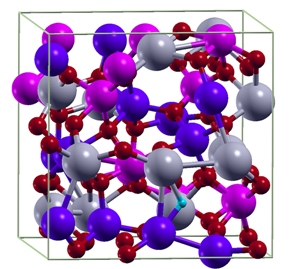Errors in the atomic structure of transparent conducting oxide (TCO) layers used in solar cells and touchscreens affect their conductivity and transparency. These errors can now be identified and removed using a practical and efficient approach developed by Fraunhofer researchers.
 Detail from a model of an amorphous oxide layer into which hydrogen atoms have been introduced in a targeted process. The tiny light-blue sphere on the bottom right is hydrogen; oxygen is represented by small red spheres; the other spheres stand for indium (gray), tin (blue), and gallium (pink). © Fraunhofer IWM
Detail from a model of an amorphous oxide layer into which hydrogen atoms have been introduced in a targeted process. The tiny light-blue sphere on the bottom right is hydrogen; oxygen is represented by small red spheres; the other spheres stand for indium (gray), tin (blue), and gallium (pink). © Fraunhofer IWM
The innovative technique simulates the properties of TCO layers by considering all potential atomic errors regardless of whether the structure is amorphous or crystalline, or the layers are disordered or highly ordered ones, thereby achieving a highly realistic model of the atomic structure of the TCO layers.
Using these simulations, the researchers explored the rate of electron movement in the TCO layer or the conductivity of the layer. According to Dr. Wolfgang Körner, one of the researchers, the simulations helped observing the changes in the density of states of a TCO layer when its atomic structure was changed. The scientists were also able to ascertain if light absorption or transmission takes place through the layer unhindered, rendering it transparent.
The study results help in gaining new insights into the origin of various properties of the TCO layers. This knowledge is useful to manufacturers to optimize their production to achieve specific oxide layer properties. Although manufacturing the structures completely free from errors is practically not feasible, the scientists have found ways to determine and remove the atomic structure defects that affect transparency in order to make more-transparent oxides.
One approach involves heating the oxides to a suitably elevated temperature or in an oxygen-rich environment, thus improving the transparency of certain TCOs. Another approach involves adding different specifically defined atoms to a TCO layer’s structure to simulate the effect of addition on the properties of the layer. The objective is to optimize the transparency and conductivity of the TCO layer by adding suitable “impurities” and to design a material by simulation in this manner.
References